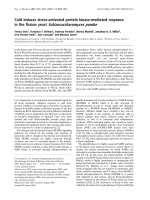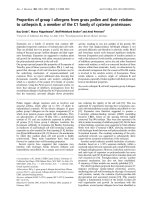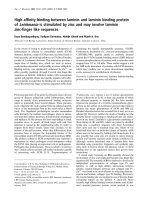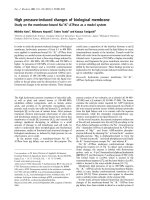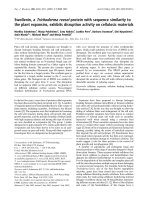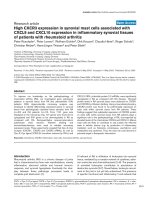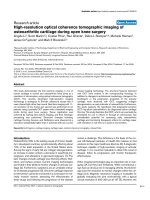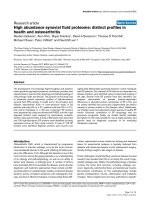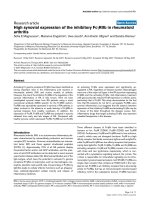Báo cáo y học: "High mobility group box-1 protein - one step closer to the clinic" docx
Bạn đang xem bản rút gọn của tài liệu. Xem và tải ngay bản đầy đủ của tài liệu tại đây (41.54 KB, 2 trang )
Page 1 of 2
(page number not for citation purposes)
Available online />Abstract
High mobility group box (HMGB)1, originally described as a
nuclear protein that binds to and modifies DNA, is now regarded
as a central mediator of inflammation by acting as a cytokine.
HMGB1 is postulated to be particularly important as a late acting
mediator of lethal septicaemia in mice. Furthermore, it has been
suggested that HMGB1 plays a role in clinical conditions such as
autoimmunity, acute ischaemia-reperfusion injury, cardiovascular
disease and cancer. HMGB1 has emerged as a candidate for
therapeutic intervention in various disease conditions. However,
further basic and clinical studies are warranted to confirm the roles
played by HMGB1 in clinical medicine.
In the previous issue of Critical Care, Kornblit and coworkers
[1] presented novel data on a possible relation between
polymorphisms in the HMGB1 gene (which encodes the high
mobility group box [HMGB]1 protein) and clinical outcome in
patients with systemic inflammatory response syndrome.
Specifically, they identified significant associations between a
promoter variant (-1377delA) and overall late survival and
between an exon 4 variant (982C>T) and early mortality due
to infection. The latter was also associated with several
clinical parameters related to disease severity. These data are
of particular interest in the light of recent research suggesting
a pathogenetic role for HMGB1 in experimental sepsis.
Definite strengths of the study are the reliable gene
technology methods they used, the prospective design of the
study, and the authors’ experience in handling genetic data in
complex clinical settings. However, clinical studies will always
be hampered by a risk for inaccurate diagnosis, despite the
existence of diagnostic criteria. This is particularly true in
patients who have a complex disease pattern and in disorders
such as systemic inflammatory response syndrome, which
have a number of underlying causes. Thus, the data
presented must be confirmed in larger studies and by other
groups before they can be used clinically to inform efforts to
predict outcome or select patients for specific treatments.
HMGB1 is constitutively expressed in the nuclei of eukaryotic
cells. It belongs to a family of high mobility group nuclear
proteins that were described in the 1970s as gene regulators
that bind to and change the configuration of DNA [2,3]. It
later became evident that HMGB1 is actively secreted from
cells, has cytokine activities and is a late mediator of
endotoxin lethality in mice [4]. Passive release of HMGB1
from necrotic cells also triggers inflammation [5]. Receptors
for HMGB1 signalling include RAGE (receptor for advanced
glycation end-products) and Toll-like receptors. HMGB1 is a
central actor in the inflammatory network because it is
induced by a number of cytokines and itself induces a series
of inflammatory reactions. More than 1,500 papers on
HMGB1 have been published. In recent years a substantial
number of studies focused on the role played by HMGB1 in
pathophysiology and disease (for reviews see [6-9]).
Attempts have been made to attenuate HMGB1-mediated
effects in experimental sepsis, including anti-HMGB1-
antibodies [4], HMGB1 antagonists [10] and neuropeptides
[11]. Inhibition of HMGB1 not only prevented development of
lethal sepsis in rodents but also reversed established sepsis,
underscoring the delayed function and potential importance
of HMGB1 in this condition. However, the road from animal
models to clinic is unpredictable. Although HMGB1 was
found to correlate with development of disseminated
intravascular coagulation [12], a study using two different
HMGB1 assays [13] demonstrated persistently increased
levels of HMGB1 in patients with sepsis, but surprisingly the
investigators found that HMGB1 measured using one of the
assays was lower in nonsurvivors than in survivors. This is
also interesting in light of the study reported by Kornblit and
Commentary
High mobility group box-1 protein - one step closer to the clinic?
Tom Eirik Mollnes
1,2
1
Institute of Immunology, University of Oslo, Rikshospitalet University Hospital, Sognsvannsv. 20, NO-0027 Oslo, Norway
2
University of Tromsø, Department of Laboratory Medicine, Nordland Hospital, Prinsensgt. 164, NO-8092 Bodø, Norway
Corresponding author: Tom Eirik Mollnes,
Published: 17 July 2008 Critical Care 2008, 12:168 (doi:10.1186/cc6944)
This article is online at />© 2008 BioMed Central Ltd
See related research by Kornblit et al., />HMGB = high mobility group box; RAGE = advanced glycation end-products.
Page 2 of 2
(page number not for citation purposes)
Critical Care Vol 12 No 4 Mollnes
coworkers [1], because the HMGB1 exon 4 variant
(982C>T), which was found to be associated with disease
severity and death due to infection, was also associated with
low HMGB1 serum concentrations. However, another study
did not identify differences in HMGB1 levels between
survivors and nonsurvivors with severe sepsis [14]. Thus,
traditional lessons must be recalled; experimental data should
always be interpreted with caution with respect to their
applicability to the human setting, and assays should be
carefully validated and compared between different labora-
tories in order to obtain reliable and consistent data. Thus,
the role for HMGB1 as a predictor of clinical sepsis or as a
therapeutic target remained to be determined.
Interest in HMGB1 extends far beyond sepsis and systemic
inflammatory response. As a pleiotropic cytokine, HMGB1 is
involved in inflammation and tissue damage in disease
conditions such as autoimmunity, acute ischaemia-reper-
fusion, cardiovascular disease and cancer. Recently, a causal
role for HMGB1 in acute myocardial infarction injury in mice
was documented [15]. Interestingly, HMGB1 appeared as
soon as 30 minutes after myocardial injury, which contrasts
with the late phase pattern seen in sepsis. The pattern of
response may therefore depend on the underlying patho-
physiology of the condition in question. This will have conse-
quences for possible treatment regimens if it ultimately trans-
pires that HMGB1 is a potential clinical intervention. If it
does, then an innumerable number of patients with various
common diseases will join the queue for such a treatment.
However, historical lessons teach us that there are good
reasons to dampen any unrealistic enthusiasm and instead
focus on conducting good research, which, step by step, will
hopefully yield greater insight into the complex biology of this
interesting molecule. Finally, it should be emphasized that
although HMGB1 may seem to be the first violinist under
certain conditions, it is but one of the players in the
inflammatory orchestra.
Competing of interests
The author declares that they have no competing interests.
References
1. Kornblit B, Munthe-Fog L, Madsen HO, Strøm J, Vindeløv L,
Garred P: Association of HMGB1 polymorphisms with
outcome in patients with systemic inflammatory response
syndrome. Crit Care 2008, 12:R83.
2. Goodwin GH, Sanders C, Johns EW: A new group of chro-
matin-associated proteins with a high content of acidic and
basic amino acids. Eur J Biochem 1973, 38:14-19.
3. Javaherian K, Liu JF, Wang JC: Nonhistone proteins HMG1 and
HMG2 change the DNA helical structure. Science 1978, 199:
1345-1346.
4. Wang HC, Bloom O, Zhang MH, Vishnubhakat JM, Ombrellino M,
Che JT, Frazier A, Yang H, Ivanova S, Borovikova L, Manogue KR,
Faist E, Abraham E, Andersson J, Andersson U, Molina PE,
Abumrad NN, Sama A, Tracey KJ: HMG-1 as a late mediator of
endotoxin lethality in mice. Science 1999, 285:248-251.
5. Scaffidi P, Misteli T, Bianchi ME: Release of chromatin protein
HMGB1 by necrotic cells triggers inflammation. Nature 2002,
418:191-195.
6. Lotze MT, Tracey KJ: High-mobility group box 1 protein
(HMGB1): nuclear weapon in the immune arsenal. Nat Rev
Immunol 2005, 5:331-342.
7. Dumitriu IE, Baruah P, Manfredi AA, Bianchi ME, Rovere-Querini
P: HMGB1: guiding immunity from within. Trends Immunol
2005, 26:381-387.
8. Bianchi ME, Manfredi AA: High-mobility group box 1 (HMGB1)
protein at the crossroads between innate and adaptive immu-
nity. Immunol Rev 2007, 220:35-46.
9. Klune JR, Dhupar R, Cardinal J, Billiar TR, Tsung A: HMGB1:
endogenous danger signaling. Mol Med 2008 [Epub ahead of
print].
10. Yang H, Ochani M, Li J, Qiang X, Tanovic M, Harris HE, Susarla
SM, Ulloa L, Wang H, DiRaimo R, Czura CJ, Wang H, Roth J,
Warren HS, Fink MP, Fenton MJ, Andersson U, Tracey KJ:
Reversing established sepsis with antagonists of endoge-
nous high-mobility group box 1. Proc Natl Acad Sci USA 2004,
101:296-301.
11. Chorny A, Delgado M: Neuropeptides rescue mice from lethal
sepsis by down-regulating secretion of the late-acting inflam-
matory mediator high mobility group box 1. Am J Pathol 2008,
172:1297-1307.
12. Hatada T, Wada H, Nobori T, Okabayashi K, Maruyama K, Abe Y,
Uemoto S, Yamada S, Maruyama I: Plasma concentrations and
importance of high mobility group box protein in the progno-
sis of organ failure in patients with disseminated intravascular
coagulation. Thromb Haemost 2005, 94:975-979.
13. Sunden-Cullberg J, Norrby-Teglund A, Treutiger CJ: The role of
high mobility group box-1 protein in severe sepsis. Curr Opin
Infect Dis 2006, 19:231-236.
14. Karlsson S, Pettila V, Tenhunen J, Laru-Sompa R, Hynninen M,
Ruokonen E: HMGB1 as a predictor of organ dysfunction and
outcome in patients with severe sepsis. Intensive Care Med
2008, 34:1046-1053.
15. Andrassy M, Volz HC, Igwe JC, Funke B, Eichberger SN, Kaya Z,
Buss S, Autschbach F, Pleger ST, Lukic IK, Bea F, Hardt SE,
Humpert PM, Bianchi ME, Mairbaurl H, Nawroth PP, Remppis A,
Katus HA, Bierhaus A: High-mobility group box-1 in ischemia-
reperfusion injury of the heart. Circulation 2008, 117:3216-
3226.

